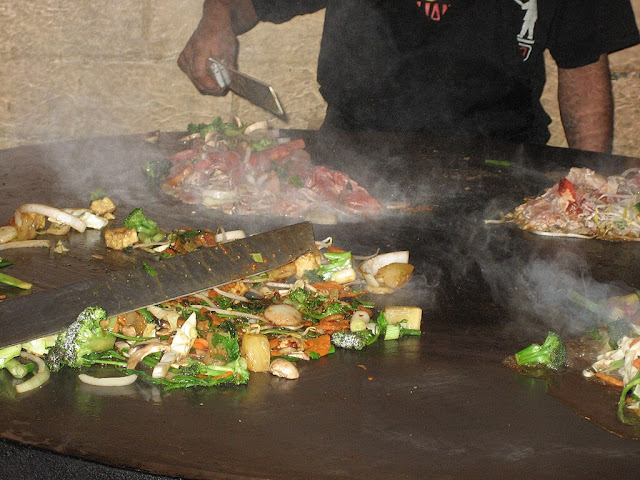 |
| By Matthew Levine from San Francisco, CA, USA - Mongolian Barbeque, CC BY 2.0, https://commons.wikimedia.org/w/index.php?curid=2087979 |
 Mongolian barbecue is a style of cooking that is often associated with stir-frying and grilling. Despite its name, Mongolian barbecue does not originate from Mongolia, but rather it was popularized in Taiwan in the mid-20th century. Here's a detailed explanation of Mongolian barbecue:
Mongolian barbecue is a style of cooking that is often associated with stir-frying and grilling. Despite its name, Mongolian barbecue does not originate from Mongolia, but rather it was popularized in Taiwan in the mid-20th century. Here's a detailed explanation of Mongolian barbecue:
Cooking Style: Mongolian barbecue typically involves a large, circular iron griddle or flat-top grill that is heated from below. The griddle is traditionally shaped like a shallow bowl to contain the ingredients and sauces. The cooking process involves stir-frying and grilling the ingredients, often in front of the diners, which adds an interactive and entertaining element to the dining experience.
Ingredients: The key components of Mongolian barbecue are thinly sliced meats, vegetables, and various sauces. The most common meats used include beef, pork, chicken, and lamb. These meats are typically marinated or seasoned before cooking. Vegetables such as cabbage, bell peppers, onions, carrots, bean sprouts, and mushrooms are also popular choices. Additionally, there are usually noodles, rice, and a variety of sauces available for customization.
Assembly and Cooking Process: At a Mongolian barbecue restaurant, the process begins with diners selecting their desired ingredients from a buffet-style spread. They can choose their preferred combination of meats, vegetables, noodles, and sauces. The selected ingredients are then handed to the grill master, who cooks them on the hot griddle. The grilling process is swift, with the ingredients being stir-fried and tossed until they are cooked to the desired level of doneness.
Sauces and Seasonings: One of the highlights of Mongolian barbecue is the wide selection of sauces and seasonings available for diners to create their own flavor profiles. Common sauces and seasonings include soy sauce, hoisin sauce, oyster sauce, sesame oil, chili sauce, garlic, ginger, and various herbs and spices. Diners can mix and match these ingredients to personalize their dishes.
Serving and Accompaniments: Once the ingredients are cooked, they are served on a plate or bowl. Mongolian barbecue is often accompanied by steamed rice or noodles to complement the flavors and provide a hearty meal. Diners can also add additional condiments or garnishes like chopped green onions, cilantro, peanuts, or sesame seeds to enhance the taste and presentation.
It's important to note that while Mongolian barbecue has become popularized and adapted in various countries, the specific cooking style and ingredients may vary depending on the region and restaurant. The concept of customization and interactive cooking remains a defining aspect of the Mongolian barbecue experience, offering diners the opportunity to create their own personalized dishes in a fun and engaging manner.
Source: Some or all of the content was generated using an AI language model

No comments:
Post a Comment
Contact The Wizard!
(he/him)